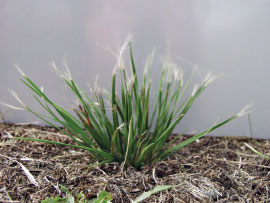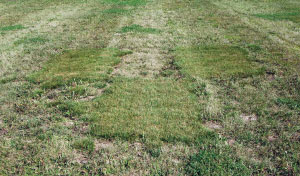Improvement of prairie junegrass as a low-input turfgrass
As economic and environmental pressures mount on superintendents to reduce inputs on their courses, turfgrass breeders have been working on developing grasses that require fewer inputs but still perform at acceptable levels.
For the past nine years, the turfgrass breeding program at the University of Minnesota has been focused on the development of lower-input turfgrasses. The grass that may have the greatest potential for long-term impact as a low-input turf in the northern half of the United States is prairie junegrass. Prairie junegrass (Koeleria macrantha) is native to much of the United States, especially the Great Plains of the western part of the country. The grass can be found growing in poor soils and stressful environments, and is known to be able to survive extreme heat and cold (Dixon, 2000).
Our research program has identified a number of strengths this species could offer a turfgrass manager including excellent winter hardiness, low fertility requirement and resistance to many common turfgrass diseases. Superintendents would also benefit from the very slow vertical growth rate seen in this species. We have had selections remain below a mowing height of three inches most of the growing season and the majority of selections only require a single mowing each month. However, this slow growth rate does not come without problems.
A FEW CONS

FIGURE 1
Many native prairie junegrass populations do not exhibit acceptable mowing quality.
One of the great weaknesses we have seen with this species is its very slow establishment rate. The same characteristic that makes this grass an excellent option once established (slow growth), greatly limits its use for many turf managers. We will continue to look for better establishing selections and will work with industry partners to look for alternate ways to improve germination and establishment rates through seed coating technology.
Another weakness of this grass is that many of the native selections go into dormancy early during a summer stress period (some European germplasm does not do this to the same extent). In addition to summer dormancy, another problem that detracts from the quality of native prairie junegrass is poor mowing quality (Fig. 1).
Finally, the species is quite susceptible to rust disease, which is often a problem in low-input management environments. We have found some resistance to our local rust races with locally collected germplasm however, we do not know if that resistance would be effective in other parts of the country.
My former graduate student, Matthew Clark, evaluated germplasm from around the world for seed production (Clark and Watkins, 2010a) as well as turf quality characteristics (Clark and Watkins, 2010b; Clark and Watkins, 2012). He found great diversity and promising turf potential in this species. A number of germplasm accessions showed turfgrass quality that would be acceptable in a low-input turf, and a number of accessions showed seed production at a level that could become economically viable. Unfortunately, an individual accession that possessed both of these characteristics (seed production and turfgrass quality) at a sufficient level was not found.
FOREIGN PRAIRIE JUNEGRASS
In addition to native populations of this grass, there are cultivars and selections that have been developed by other breeders using European germplasm. These grasses have greater turf quality and performance than the native material we have evaluated.

Figure 2
European-derived cultivars and selections of prairie junegrass provide an excellent low-input turf, but are not widely used due to poor seed production and seed quality. In this photo, three European cultivars are surrounded by native populations with poor turf quality.
In fall of 2008, we planted a dormant-seeded trial of prairie junegrass that consisted of germplasm from North America, as well as from a number of countries in Europe and Asia. We also included cultivars developed from European germplasm, such as Barleria and Barkoel, both developed by Barenbrug.
Since the trial was established in spring 2009, the plots have received no fertilizer, no pesticides, minimal mowing (one to two times per month) and no supplemental irrigation. Figure 2 shows an example of some of the top performing cultivars in summer 2013.
These plots grow slowly, stay green all summer, green up rapidly in the spring and experience little disease pressure. Unfortunately, for the most part, these European selections do not produce enough seed that is of the quality necessary for a highly used cultivar. As you can see in Figure 2, some of the plots that surround these grasses are performing poorly and do not have adequate turfgrass quality; these are the populations that can produce seed. In the next few years, we will be working with industry partners to combine these traits into a more widely adapted cultivar that can produce seed at acceptable levels.
NOT QUITE READY FOR ROUGH
An improved prairie junegrass variety could be utilized in golf course roughs where lower inputs of water, fertilizer and pesticides are desired. Maintaining acceptable quality turf without any inputs other than occasional mowing would make this grass more desirable than many of the grasses found in golf course roughs in the northern United States today.
Developing new turfgrass varieties takes several years, and in the case of a ‘new’ species such as prairie junegrass, the timeline is significantly longer. Nevertheless, we will continue an aggressive breeding program that aims to provide an excellent, low-input turfgrass option for superintendents throughout much of the United States.
Acknowledgment
The author would like to thank the United States Golf Association for their financial support of this project. Additional funds were provided by the Minnesota Agricultural Experiment Station.
References
Clark, M.D., and E. Watkins. 2010a. Seed production characteristics of prairie junegrass germplasm accessions. Crop Sci. 50:1057-1065.
Clark, M.D., and E. Watkins. 2010b. Turfgrass characteristics of prairie junegrass germplasm accessions. Crop Sci. 50:2092-2102.
Clark, M.D., and E. Watkins. 2012. Broad-sense heritability estimates of turfgrass performance characteristics in native prairie junegrass germplasm. HortScience 47:1228-1233.
Dixon, J.M. 2000. Koeleria macrantha (Ledeb.) Schultes (K. alpigena Domin, K. cristata (L.) Pers. pro parte, K. gracilis Pers., K. albescens auct. non DC.). J. Ecol. 88:709-726.
Photos: Eric Watkins








